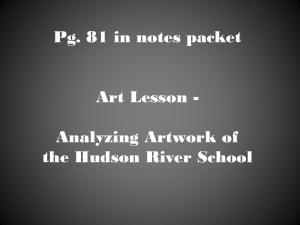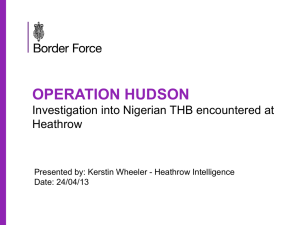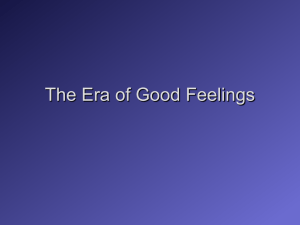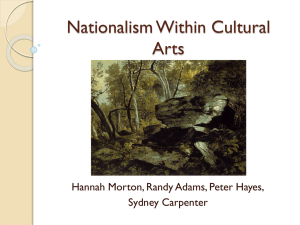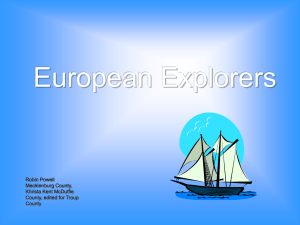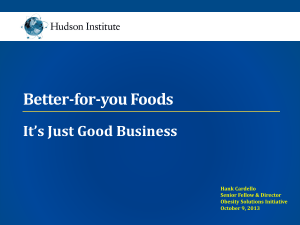Hudson River Valley: Environmental Problems
advertisement
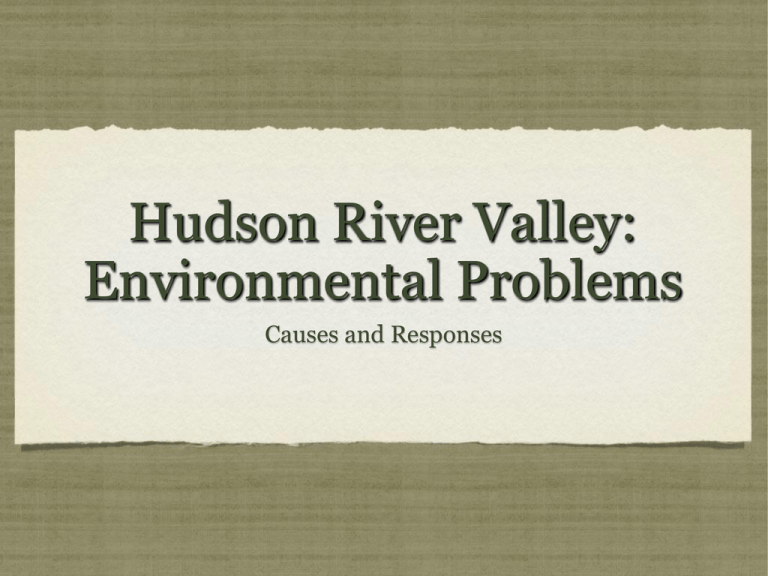
Hudson River Valley: Environmental Problems Causes and Responses Discovering Resources The Hudson River Valley’s attractive natural features were valued, but taken advantage of to its degradation An estimated 90 percent of New York was densely forested when the first European settlers arrived Forests were cleared to make way for agriculture and towns and to fuel industries such as tanning, paper, and charcoal Using and Abusing The area is valuable to industrialization The Hudson River provided Abundant water supply Fast currents for powering machinery Easy means of waste disposal This resulted in massive deforestation, the introduction of invasive species, and the burning of forest land to clear the way for agriculture Cause: Lumber Man-forced removal of trees - seen with the industrial revolution quickened the pace and scale of resource consumption - without sufficient reforestation can result in damage to the habitat Woodlands were used firewood to produce the steam that powered factories and steamboats White pine forests were cut for the shipbuilding industry Pine was cut for charcoal for iron foundries Hemlocks were stripped of bark to supply tanneries Whole forests in the Catskills were destroyed to meet the demands for leather The Pratt tannery, at Schohariekill, consumed 6000 cords of bark a year (15 cords = 75 trees) Cause: Blast Furnaces Blast furnaces are large devices used for smelting to produce industrial metals, like iron, where fuel and ore are continuously supplied through the top of the furnace and air is blown into the bottom of the chamber The chemical reactions that take place in the blast furnace due to the intense heating process can cause hazardous chemicals to be released into the soil near blast furnace industries in 1827 the West Point Foundry in Cold Spring began operating a charcoal-fueled blast furnace bordering the foundry complex, but managers stopped operating the furnace by 1844 due to environmental pollution to surrounding forests due to harmful effects on the soil Cause: Railroads The Metro-North Railroad has tracks that range from Port Jervis, Spring Valley, Poughkeepsie, and Wassaic to New York City In the construction of all the rail trails in the Hudson Valley, many trees were cut down, burned, and used for the tracks themselves The construction of the railways in the Hudson Valley is a direct cause of deforestation Cause: Coal Burning Once access to the mines of Pennsylvania was secured via the D&H Canal, coal replaced wood as the favored fuel; coal burning contributes to acid rain, smog, and global warming Acid rain causes the deaths of trees and is a leading cause of deforestation Oil refineries and petrochemical industries used the Hudson and other waterways as convenient sewers for flushing toxic wastes Acid sludge is a byproduct of oil refining and causes soil erosion and settles into riverbed sediments Cause: Pollution The flagrant pollution of the Hudson presaged the poisoning of the waters and soils through the 20th century, as more lethal chemicals were manufactured: pesticides like DDT, and PCBs GE was one of the worst polluters in discharging tons of PCBs into the Hudson from its plant at Fort Edward on the upper Hudson after it received the blessing of the federal government in 1930 to do so in 1980, Congress passed the Superfund Act, which required industrial polluters to clean up their act, but GE has dragged its feet, tying up cases in the courts to avoid compliance with the EPA order to clean up the Hudson Cause: Agriculture The overwhelming cause of deforestation in the Hudson River Valley is agriculture Subsistence farming is responsible for 48% of deforestation The Hudson Valley produces a variety of field crops: corn, oats, wheat, apple orchards, farm wineries, and a dairy industry All of these sectors require land to be cleared of trees Cause: Nuclear Power In the 1960s, Con Ed built a nuclear reactor at Indian Point, just 24 miles north of New York, on the Hudson’s east bank The plant kills millions of fish by sucking them into their turbines and cooking them in heated discharge water Hudson Riverkeeper has kept up a constant legal battle with Con Ed over the Fishkill plant Recently won a ruling to shut down the plant’s cooling operations Reversal: Hudson Riverkeeper Hudson Riverkeeper, founded in 1966, is an environmental non-profit dedicated to the protection of the Hudson River and its watersheds that provide the New York City community with its drinking water In 1984, Robert F. Kennedy Jr. joined the organization to accomplish a court-mandated 1,500 hours of community service Kennedy teamed with Riverkeeper to sue polluters of the Hudson River, and after his 1,500 hours were complete, the group hired Kennedy as its chief prosecuting attorney Kennedy also founded and is the current chairman of the organization Waterkeeper Alliance, which connects and supports local Waterkeeper groups all along the Hudson River Reversal: Clearwater In 1966, folk singer Peter Seeger co-founded Hudson River Sloop Clearwater, an environmental education organization that promotes awareness of the river and its history Clearwater is recognized for its role in forcing the clean-up of PCB contamination of the Hudson River caused by GE and other industrial manufacturing companies on the river's edge GE's Hudson Falls and Fort Edward facilities discharged between 209,000 pounds and 1.3 million pounds of PCBs into the river from 1947 to 1977 The United States Environmental Protection Agency declared a two hundred mile stretch of the river, from Hudson Falls to New York City, to be a site requiring cleanup in 1983 (GE finally began cleaning up the PCBs in 2009) Reversal: Community Support The Hudson River Valley is home to some of the country’s wealthiest landowners, including the Rockefeller, Morgan, Harriman, and Perkin families, and these powerful families set the stage for preservation to take place at an unprecedented scale Owning vast amounts of land throughout the region, they had the power, money, and the commitment to protect the environment of the Hudson River Valley In part of their efforts, New York State established parks, preserves, and the nation’s first greenbelt Today, the descendents of these families continue to donate time, land and money to fill in the unprotected gaps across the region Cause and Reversal: Conclusion Enhanced regulation and greater public awareness have made sizable stretches of the river clean enough for both humans and fish species, and in many ways, both the Hudson River and its surrounding valley are cleaner and more protected today than they have been in centuries The story of the Hudson River - its flowing waters and fertile valley and the people who inhabit its environment - and its environmental challenges is far from over What lies next for the Hudson River Valley is yet to be determined, but is dictated by concerned individuals with an aim at protecting the valley and its inhabitants
